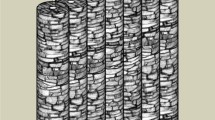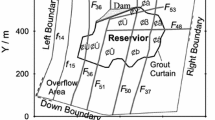Abstract
This study describes the effectiveness of permeation grouting applied for remedial works of the defected earth fill dam located in Korea. A small cavity was discovered in some part on the crest of the dam when the reservoir water level rose to 150m after the first impounding in June 1998. Although the cavity was backfilled with gravel and rubble, collapsing, of the sinkhole was continuously taking place. Thus, a comprehensive investigation such as electric resistivity test borehole test, tracer test et al. was planed and executed to detect the leakage and the sinkhole developed in the earth dam. Based on the results of the investigation, the compaction grouting program was carried out in June 2000. Observations made after the completion of the compaction grouting showed that the leakage generally decreased below the reservoir of elevation 138m. However, the leakage and turbidity through the embankment increased over the elevation 138 m. The possibility of weakness formation in dam body was arisen around the water elevation 145≈150 m. Thus, the permeation grouting method after compaction grouting application was applied for additional remedial work of the defected dam to establish the permanent safety. Permeation grouting method, combining with fracture grouting, was recommended for the core zones. Permeation grouting with either particulate or chemical grouts is utilized to give cohesion or to reduce the permeability soils. Portlant cement grouting was performed first and micro cement was then grouted through the upsteam portion of the dam. After the permeation grouting consecution, seepage quantity trend of the earth-fill dam was stable and dependent on the reservoir level, and defected dam was effectively repaired. The permeation grouting application significantly reduced leakage to 4≈50 m3/day compared with initial damaged stage of 2500m3/day and compaction grouting of 800m3/day application. The seepage quantity significantly reduced from 640 m3/day to 4.1m3/day after applying the permeation grouting method, and the leakage decreased from 2,500 m3/day to 800 m3/day.
Similar content being viewed by others
References
Bernell, L. (1976). “Control of Leakage Through Dams Founded on Glacial Till Deposits”.International Congress on Large Dams, Mexico, Q. 45, R. 56.
Brown, D. R., and Warner J. (1973). “Compaction Grouting, Journal of the Soil Mechanics and Foundation Division”.ASCE, Vol. 99, No. SM8, pp. 589–601.
Denver Korea Grouting Co. and Hayward Baker International. (2000).Final report on investigation and reinforcement of sink hole in Unmum Dam Core (,,Step).
Dhar, D. K. (2004). “Environmental Considerations for Sustainable Dam Projects.”International Conference On Large Dam (ICOLD) 72 nd Annual Meeting, Proceedings Workshop on Dam Safety Problems and Solutions-Sharing Experience, pp. 36–43.
Korea Water Resources Corporation. (2000).Report on Precise Safety Diagnosis of Gyeongbuk Cheongdo-gun, Unmun Dam.
Korea Infrastructure Safety and Technology Corporation. (2005).Report on Detail Safety Investigation for Unmun Dam.
Lim, H. D., K. H. Lee, J. Y. Lee, and B. H. Oh. (2004). “Leakage investigation, remedial work and its effects on seepage control of earth fill dam.”International Conference On Large Dam (ICOLD) 72 nd Annual Meeting, Proceedings Workshop on Dam Safety Problems and Solutions-Sharing Experience.
Salembier, M., G. Vassiliadis, Y. Le Nindre, and A. A. Souhangir. (1998). “Leakage Investigations Safety Analysis and Proposed Remedial Measures at Large Dam”.Proc., 66th ICOLD Annual Meeting, New Delhi, pp. 85–95.
Seemel, R. N., and C. N. Colwell. (1976). “Drainage Provision and Leakage Investigations of Churchill Falls Dams and Dykes”.International Congress on Large Dams, Mexico, Q. 45, R. 8.
Stewart, R. A., P. C. Gaffra B. D. Watts, J. C. Sobkowicz, and A. G. Kupper. (1998)WAC Bennett Dam-The Characterization of a Crest Sinkhole, Geotechnical Site Characterization, edited by Robertson and Mayne Belkema, Rotterdam.
Warner, J. (1982). “Compaction Grouting-The First Thirty Years.”Proceedings. of the Conference on Grouting in Geotechnical Engineering, ASCE, pp. 694–706.
Weaver, K. D. (1993). “Some Considerations for Remedial Grouting for Seepage Control, Specialty Conference on Geotechnical Practice in Dam Rehabilitation.”.Geotechnical Division ASCE, New York.
Youngnam University & Daebon Engineering Co. (2001).Final Report on Stability Assessment and Countermeasures of Repair and Reinforcement for Unmun Dam.
Author information
Authors and Affiliations
Corresponding author
Rights and permissions
About this article
Cite this article
Chun, B.S., Lee, Y.J. & Chung, H.I. Effectiveness of leakage control after application of permeation grouting to earth fill dam. KSCE J Civ Eng 10, 405–414 (2006). https://doi.org/10.1007/BF02823979
Received:
Accepted:
Issue Date:
DOI: https://doi.org/10.1007/BF02823979




